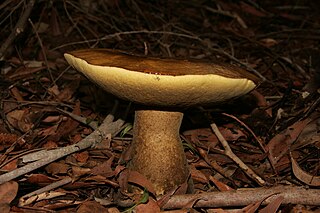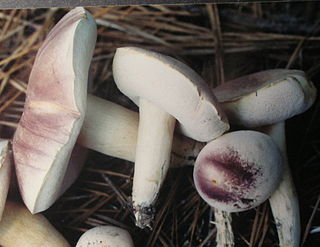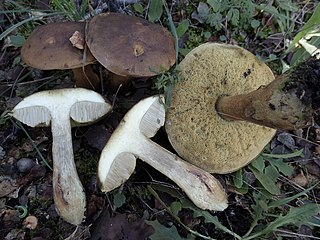
The Boletaceae are a family of mushroom-forming fungi, primarily characterised by small pores on the spore-bearing hymenial surface, instead of gills as are found in most agarics. Nearly as widely distributed as the agarics, the family is renowned for hosting some prime edible species highly sought after by mushroom hunters worldwide, such as the cep or king bolete . A number of rare or threatened species are also present in the family, that have become the focus of increasing conservation concerns. As a whole, the typical members of the family are commonly known as boletes.

Phlebopus marginatus, commonly known as the salmon gum mushroom in Western Australia, is a member of the Boletales or pored fungi. An imposing sight in forests of south-eastern and south-western Australia, it is possibly Australia's largest terrestrial mushroom, with the weight of one specimen from Victoria recorded at 29 kg (64 lb). Initially described in 1845 as Boletus marginatus, and also previously known by scientific names such as Phaeogyroporus portentosus and Boletus portentosus, it is not as closely related to typical boletes as previously thought.
Gastón Guzmán Huerta, a Mexican mycologist and anthropologist, was an authority on the genus Psilocybe.

Alexander Hanchett Smith was an American mycologist known for his extensive contributions to the taxonomy and phylogeny of the higher fungi, especially the agarics.

Calostoma is a genus of 29 species of gasteroid fungi in the suborder Sclerodermatineae. Like other gasteroid fungi, Calostoma do not have the spore discharge mechanism associated with typical gilled fungi (ballistospory), and instead have enclosed spore-bearing structures. Resembling round puffballs with raised, brightly colored spore openings (ostioles), elevated on a thick, gelatinous stalks, species have been collected in regions of deciduous, temperate, tropical or subtropical forests. Their distribution includes eastern North America, Central America, Asia, and Australasia. The common name given to some species, "prettymouth", alludes to the brightly colored raised openings (ostioles) that may somewhat resemble lips. Other common names include "hotlips" and "puffball in aspic".

Afroboletus is a genus of fungi in the family Boletaceae. The genus, circumscribed in 1981, contains seven species found in tropical Africa.

Boletellus is a genus of fungi in the family Boletaceae. The genus has a widespread distribution, especially in subtropical regions, and contains about 50 species. The genus was first described by American mycologist William Alphonso Murrill in 1909. The genus name means "small Boletus".

Hygrophoropsis is a genus of gilled fungi in the family Hygrophoropsidaceae. It was circumscribed in 1888 to contain the type species, H. aurantiaca, a widespread fungus that, based on its appearance, has been affiliated with Cantharellus, Clitocybe, and Paxillus. Modern molecular phylogenetic analysis shows that the genus belongs to the suborder Coniophorineae of the order Boletales.

Psilocybe hoogshagenii is a species of psilocybin mushroom in the family Hymenogastraceae. The mushroom has a brownish conical or bell-shaped cap up to 3 cm (1.2 in) wide that has an extended papilla up to 4 mm long. The stem is slender and 5 to 9 cm long. The variety P. hoogshagenii var. convexa lacks the long papilla.

Suillus sibiricus is a mushroom-forming fungus in the family Suillaceae. It is found in mountains of Europe, North America, and Siberia, strictly associated with several species of pine tree. Due to its specific habitat and rarity in Europe, it has been selected for inclusion in several regional Red Lists. Its fruit bodies are characterised by having slimy caps in wet weather, which can reach diameters of up to 10 cm (3.9 in). On the underside of the cap are yellow angular pores that bruise a pinkish to cinnamon colour. The stem is up to 8 cm (3.1 in) tall and 2.5 cm (1.0 in) wide and typically has a ring, a remnant of the partial veil that covers the fruit body in its early development. In North America, it is commonly called the Siberian slippery jack. Phylogenetic analysis has shown that S. sibiricus is closely related to S. umbonatus and S. americanus, and may in fact be conspecific with the latter species.

Boletellus ananas, commonly known as the pineapple bolete, is a mushroom in the family Boletaceae, and the type species of the genus Boletellus. It is distributed in southeastern North America, northeastern South America, Asia, and New Zealand, where it grows scattered or in groups on the ground, often at the base of oak and pine trees. The fruit body is characterized by the reddish-pink scales on the cap that are often found hanging from the edge. The pore surface on the underside of the cap is made of irregular or angular pores up to 2 mm wide that bruise a blue color. It is yellow when young but ages to a deep olive-brown color. Microscopically, B. ananas is distinguished by large spores with cross striae on the ridges and spirally encrusted hyphae in the marginal appendiculae and flesh of the stem. Previously known as Boletus ananas and Boletus coccinea, the species was given its current name by William Alphonso Murrill in 1909. Two varieties of Boletellus ananas have been described. Like many other boletes, this species is considered edible, but it is not recommended for consumption.

Austropaxillus is a genus of fungi in the family Serpulaceae, containing nine species found in Australia, New Zealand and South America.

Suillus cothurnatus is a species of mushroom in the genus Suillus. Found in Malaysia, Brazil, and North America, it was first described scientifically by mycologist Rolf Singer in 1945.

Tylopilus williamsii is a bolete fungus in the family Boletaceae found in Mexico, where it grows under oak. It was described as new to science in 1991.

Fistulinella wolfeana is a bolete fungus in the family Boletaceae found in Hidalgo, Mexico, where it grows under pine and oak in mixed forest. It was described as new to science in 1991.
Fistulinella alfaroae is a bolete fungus in the family Boletaceae found in Costa Rica. It grows with Monotropa under oak in montane forest. It was described as new to science in 1991.

Fistulinella mollis, commonly known as the marshmallow bolete, is a bolete fungus in the family Boletaceae found in Australia.

Fistulinella nivea is a species of bolete fungus in the family Boletaceae found in New Zealand. First described by mycologist Greta Stevenson in 1962 as a species of Tylopilus, it was transferred to the genus Fistulinella by Rolf Singer. Stevenson originally discovered the bolete in 1955 at Tōtaranui, where it was growing under Nothofagus. Its fruitbody has a white cap with a diameter of up to 3 cm (1.2 in) atop a stipe measuring up 7 cm (2.8 in) long and 1–1.5 cm (0.4–0.6 in) thick. The pores on the cap underside are up to 1.5 mm in diameter. The pore surface is initially white before changing to pale pink. Spores are ellipsoid, hyaline (translucent), and measure 17–18 by 6–7 μm.

Leccinellum lepidum is a species of bolete in the family Boletaceae. Originally described as Boletus lepidus in 1965, the fungus has gone through controversial taxonomic treatments over the years and was subsequently transferred to genus Krombholziella in 1985, to genus Leccinum in 1990, and to genus Leccinellum in 2003. It is the sister-species of Leccinellum corsicum, with which it had been erroneously synonymised by some authors in the past.

























